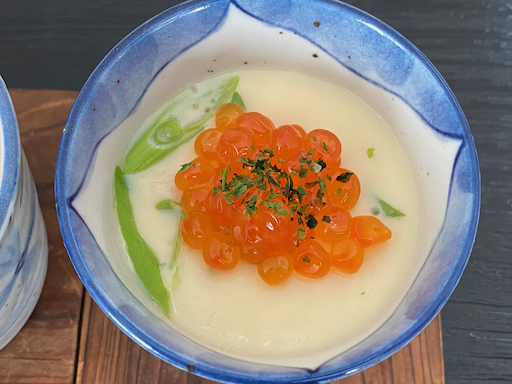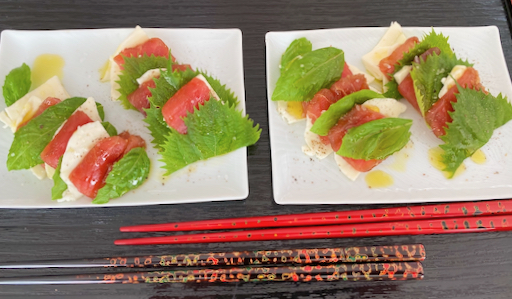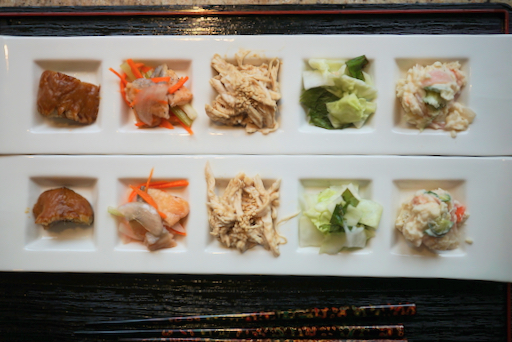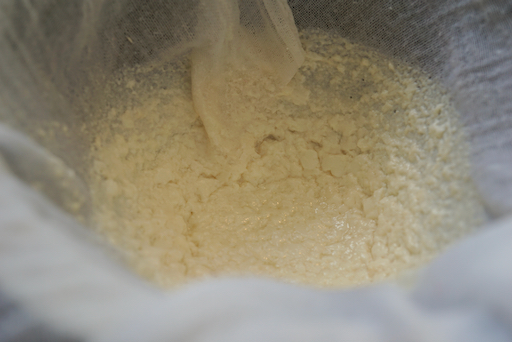This is a continuation of the “using up yellowfin tuna sashimi block”. We started with “Tuna caprese” and proceeded with the cold chawan-mushi. This was the third appetizer and second tuna sashimi dish. Without knowing specifically what I would make, I marinated 1/3 block of tuna sashimi “saku” block sliced in concentrated Japanese noodle sauce or “mentsuyu” 麺つゆ to make “Zuke tuna” 漬けマグロ. I could have served as it is or as “yama-kake” 山かけ but I did not have any nagaimo 長芋. I did have daikon 大根, however, so I made this dish.
Wednesday, September 16, 2020
Marinated tuna sashimi with grated Daikon 鮪のおろし和え
Sunday, September 13, 2020
Chawan-mushi with “ikura” salmon roe 冷製茶碗蒸しイクラのせ
This is not a new dish but it was the second appetizer for the evening when we had the tuna caprese as the first dish. This is a cold chawan-mushi which I made in the morning. I topped it with “ikura” salmon roe and garnished with “ao-nori” 青海苔 a type of dried green seaweed called laver.
Ingredients: (for 6 small cups such as the sized container shown above)
3 large eggs (150-170 ml)
Broth, three times volume of the eggs (450- 520ml). Any broth including chicken broth will do. I used a mixture of bonito and kelp broth from a dashi-pack and broth I made from shrimp shells. I seasoned the broth with mirin, light colored soy sauce and salt.
6 large frozen shrimp, shell on, thawed, salted, let it stand for 5-10 minutes, shelled and cut into bite sized pieces.
1 cooked chicken tenderloin, shredded.
1/2 scallion, sliced on bias.
Directions
In 6 small bowls, add the shrimp, chicken, and scallion. Mix the eggs and seasoned cold broth, pour the egg mixture through a fine sieve. Steam (I used an electric wok) on high stream for 10 minutes and then lowered the steam and keep steaming until the egg mixture was set (another 10-15 minutes or more).
Instead of eating this hot, I let it cool to room temperature and refrigerated it. I served it cold with Ikura and dried “ao-nori” on top.
Since I did not have other items such as shiitake mushrooms, I used whatever was available. This simpler approach worked very well for this cold chawan-mushi. The addition of the ikura salmon worked very well. It provided a nice texture with a delicate pop in the mouth followed by a burst of fresh sea saltiness. After this we had another tuna dish.
Thursday, September 10, 2020
Tuna sashimi caprese with basil and perilla 漬けマグロのカプレーゼ
Ingredients: (for an appetizer for two)
1/3 tuna “saku” block, sliced into 6 slices (3 slices per serving)
6 slices of fresh mozzarella cheese
6 basil leaves
6 perilla leaves (if large cut into two)
Good olive oil (I used our favorite Spanish olive oil)
Salt and pepper
Marinade:
2 tbs soy sauce
1 small clove of garlic, crushed using a garlic press (or grated from tube).
1/2 tsp. sugar
Directions
Add the marinade and the tuna into a Ziploc bag, remove the air, seal and marinate for 10-15 minutes. Blot out excess marinade (I decided to cut one slice into two so that I could make the basil and perilla versions). Layer the mozzarella cheese, tuna, and either basil or perilla. Sprinkle with the olive oil, salt, and freshly cracked black pepper.
This was a really good way to have tuna sashimi. The addition of garlic in the marinade made it really good. Both the basil and perilla versions while different were good. We thought both are good but the perilla ones had stronger and more distinct flavor.
Monday, September 7, 2020
Cabbage and perilla in brine キャベツの青じそ漬け
4-5 Green perilla leaves, cut into 1cm square
1/2 cup hot water
1 tsp salt
1/2 tsp sugar
1/2 tsp rice vinegar
In a Ziploc bag, add the cabbage and green perilla, pour in the brine, remove the air as much as you can and seal. Sandwich the bag between two plates and put the weight and let it stand for 30 minutes until more water comes out and the cabbage becomes soft. It will keep several days in the refrigerator.
The brine was rather gentle and the cabbage tasted fresh and had a nice crunch. eating it with the perilla pieces really made it. This is a nice refreshing dish.
Friday, September 4, 2020
Homemade Ricotta cheese 自家製リッコタチーズ
2 gallons fresh whey (use within a few hours of straining)
1 gallon milk (optional)
1/2 cup distilled white vinegar
1 cup whey
1 cup milk (optional)
1/8 cup vinegar (she used rice vinegar)
salt to taste.
Drain the curd through a butter cheese cloth (picture below). One hour draining for soft ricotta. Six or more hours for firmer ricotta. Remove from the cloth, put it into a small bowl and salt to taste.
Tuesday, September 1, 2020
Super-soft Milk Bread 日本風食パン
Many years ago, when we visited Tokyo 東京, we stayed at hotels in the Asakusa area 浅草. (More recently, we've been staying at hotels in the Ginza/Tokyo station area). One of the fond memories we have of our stay at the Asakusa hotels was going to a coffee house or "Kissa-ten" 喫茶店 for breakfast and coffee. At that time, they usually offered, at a very reasonable price, choices of "morning sets" モーニングセットdesignated as "A", "B" or "C". They consisted of some kind of egg (hard boiled or egg salad) and slightly different sides such as a mini green salad or cucumber. The foundation of the meal, and, as far as we are concerned, the best part, was a very thick slice of soft bread lightly toasted and served with butter or sometimes jam or jelly. The second cup of coffee was usually available at a steep discount which was another reason we liked breakfast at the Kissa-ten. Recently my wife came across a recipe for "Super-soft Milk Bread". In addition to being reminiscent of our favorite Kissa-ten bread, the accompanying write-up referred to it as a variation of "Hokkaido milk bread". Since I am originally from Hokkaido 北海道, that "sealed the deal". I had to make this. This is a very different recipe from our usual white bread loaf. It came out super soft, light and fluffy. It really reminded us of "Kissa-ten" toast. I sliced a very thick piece (but not as thick as some we had at kissa-ten) toasted it and slathered on the butter. Voila!
Tangzhong
3 tablespoons (43g) water
3 tablespoons (43g) whole milk
2 tablespoons (14g) King Arthur Unbleached Bread Flour
Dough
2 1/2 cups (298g) King Arthur Unbleached Bread Flour
2 tablespoons (14g) Baker's Special Dry Milk or nonfat dry milk
1/4 cup (50g) sugar
1 teaspoon salt
1 tablespoon instant yeast (This looked like too much for one loaf of bread, next time I may reduced it in half)
1/2 cup (113g) whole milk
1 large egg
4 tablespoons (57g) unsalted butter, melted
I weighed all ingredients except for the yeast and egg.
Directions
Place the saucepan over low heat and cook the mixture, whisking constantly, until it becomes thick and the whisk leaves lines on the bottom of the pan, about 3 to 5 minutes (#1 below).
Transfer the tangzhong to a small mixing bowl or measuring cup and let it cool to lukewarm.
To make the dough
Combine the tangzhong with the remaining dough ingredients, then mix and knead — by mixer or bread machine — until a smooth, elastic dough forms; this could take almost 15 minutes in a stand mixer (I used a standing mixer with a dough hook and kneaded it for 7-10 minutes).
Shape the dough into a ball, and let it rest in a lightly greased bowl, covered, for 60 to 90 minutes, until puffy but not necessarily doubled in bulk.
Flatten each piece of dough into a 5" x 8" rectangle, then fold the short ends in towards one another like a letter. Flatten the folded pieces into rectangles again (this time about 3" x 6") and, starting with a short end, roll them each into a 4" log. (After flattening, folding, I rolled it into two logs).
Place the logs in a row of four (in my case, two) — seam side down and side by side — in a lightly greased 9" x 5" loaf pan.
Cover the loaf and allow it to rest/rise for 40 to 50 minutes, until puffy (#2 below).
Toward the end of the rising time, preheat the oven to 350°F.
To bake the bread: Brush the loaf with milk and bake it for 30 to 35 minutes, until it's golden brown on top and a digital thermometer inserted into the center reads at least 190°F (#3 below).
Remove the loaf from the oven and cool it in the pan until you can transfer it safely to a rack to cool completely (#4).
The dough rose rather quickly (this is the reason I think I will reduce the yeast next time). After the bread completely cooled, I sliced it (#4).We have been making white bread loafs for some time using an old recipe which came with our stand mixer. Our white bread loaf is good but this one is different and may be better. It is extremely light and very close to the Japanese loaf bread we had at the Kissa-ten. We were "transported" back to Tokyo with the first bite. It had a mildly sweet flavor and the crust was nice and crunchy. We will definitely make this again for sure.
Addendum:
I doubled the amount and made two loaves. I also, decreased the yeast by half (proportionally). I also weighed the 4 portions (2 for one loaf) and they came out in equal sizes (see pictures below). This is just a note to myself so that I do not have to calculate the ingredients' weight again.
Ingredients:
86 g water
86 g whole milk
28 g King Arthur Unbleached Bread Flour
Dough
596 g King Arthur Unbleached Bread Flour
28 g nonfat dry milk
100 g sugar
2 teaspoon salt
1 tablespoon instant yeast
226 g whole milk
2 large egg
114 g (one stick) unsalted butter, melted
Thursday, August 27, 2020
Red wine miso sauce with tuna cutlet 赤ワイン味噌ソースとマグロカツ
I thawed a block "saku" of low-grade yellowfin tuna sashimi. As usual, I tried to make some variation dishes. First I made "zuke" marinated tuna cubes with avocado very similar to one I posted. The second dish was imitation "negitoro " ネギトロ. These two dishes are very good with cold house sake "Tengu-mai" 天狗舞大吟醸. The third dish I made was tuna cutlet マグロカツ. I gave a twist to this dish by making a red wine miso sauce and serving it with our relatively new house red wine DAOU Vineyards “Pessimist” Red Blend 2018. I saw the sauce recipe in a digital version of the Japanese newspaper “Asahi “ 朝日新聞. The recipe was written by a sommelier. It is a reduced red wine with miso and he claimed that, with this sauce, the food will go well with red wine. He also suggested fried food would be the best with this sauce. I served tuna cutlet with this sauce accompanied with cucumber and cabbage “asazuke” 浅漬け as well as the cauliflower I usually make and skinned Campari tomato.
The reason I made this sauce was because one of the bottles of red wine we opened recently had a bit of a musty taste/oder and we decided not to drink it. It was not corked but somehow the handling was not right since other bottles of the same wine were ok. Also we have had this wine so many time in the past with no problems. In any case, I used a portion of this wine to make a chicken liver dish, a stew of leftover barbecued chicken, and this red wine miso sauce to finish the bottle. Once cooked, the wine lost its mustiness.
IngredientsRed wine 200 ml
Red miso 2 tbs (I did not have red miso 赤味噌 and used “awase” miso 合わせ味噌)
Mirin 2 tsp
Rice vinegar 2 tsp
light colored soy sauce 2 tsp
Honey 2 tsp or more to taste
Reduce the red wine in half, dissolve the miso and add other ingredients and adjust sweetness to your liking by adding more honey.
I added more honey than indicated. I had to strain the sauce since it developed some sediments (due to vinegar?). I served it on the fried tuna and the fried taste completely dominated. We actually couldn’t taste the sauce at all. My wife, who never skimps when it comes to the application of sauces actually took to soaking her pieces of tuna in the sauce and said she still couldn’t taste it. Finally, in desperation she slurped it with a spoon and conceded it tasted very nice. I would have expected to at least taste the miso flavor but it was completely muted. I am not sure this may have been because I did not use red miso. In any case, this sauce did not have much flavor but we enjoyed the tuna cutlets with red wine. Since more sauce is left, I may add more miso to see if that will improve the flavor.


















